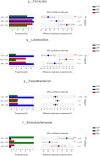Lycium barbarum Polysaccharides as Antibiotic Substitutes Improve Growth Performance, Serum Immunity, Antioxidant Status, and Intestinal Health for Weaned Piglets
- PMID: 35281314
- PMCID: PMC8914510
- DOI: 10.3389/fmicb.2021.819993
Lycium barbarum Polysaccharides as Antibiotic Substitutes Improve Growth Performance, Serum Immunity, Antioxidant Status, and Intestinal Health for Weaned Piglets
Abstract
The aim of the present study is to investigate the effects of dietary Lycium barbarum polysaccharides (LBPs) supplementation on the growth performance, immune response, serum antioxidant status, and intestinal health of weaned piglets. In total, 24 crossed healthy weaned piglets [Duroc × (Yorkshire × Landrace)], of similar body weight (7.47 ± 0.22 kg), were randomly allocated to three treatment groups: CON (basal diet); LBPs (basal diet plus 4,000 mg/kg LBPs); and antibiotic (ABO, basal diet plus 20 mg/kg flavomycin and 50 mg/kg quinocetone). There were eight pigs per group. The study lasted 28 days. When compared with CON, LBPs or ABO dietary supplementation increased average daily gain (P < 0.05), decreased the ratio of feed to gain and the diarrhea ratio (P < 0.05). Similarly, when compared with CON, LBPs dietary supplementation increased serum immunoglobulin G, immunoglobulin M, interleukin-10, interleukin-2, and tumor necrosis factor-α levels (P < 0.05). Dietary LBPs enhanced the activity of serum total antioxidant capacity and glutathione peroxidase, and decreased malondialdehyde levels (P < 0.05). Principal component analysis showed a distinct separation between CON and LBPs groups, but no differences between ABO and LBPs groups. LBPs addition increased Lactobacillus and Faecalibacterium (P < 0.05) levels, while it decreased Enterococcaceae and Enterobacteriaceae (P < 0.05) levels. Furthermore, when compared with the CON group, LBPs increased villus height (P < 0.05) and the villus height to crypt depth ratio in the duodenum and jejunum (P < 0.05). Thus, dietary supplementation with LBPs improved growth performance, antioxidant capacity and immunity, regulated intestinal microbial composition, and may be used as an efficient antibiotic alternative in weaned piglet feed.
Keywords: Lycium barbarum polysaccharides; antioxidant; growth performance; immune; intestinal health; weaned piglets.
Copyright © 2022 Yin, Wang, Yang, Tan, Yin, Chen and Yang.
Conflict of interest statement
The authors declare that the research was conducted in the absence of any commercial or financial relationships that could be construed as a potential conflict of interest.
Figures




References
-
- Burke N. C., Scaglia G., Boland H. T., Swecker W. S. (2009). Influence of two-stage weaning with subsequent transport on body weight, plasma lipid peroxidation, plasma selenium, and on leukocyte glutathione peroxidase and glutathione reductase activity in beef calves. Vet. Immunol. Immunopathol. 127 365–370. 10.1016/j.vetimm.2008.11.017 - DOI - PubMed
LinkOut - more resources
Full Text Sources

